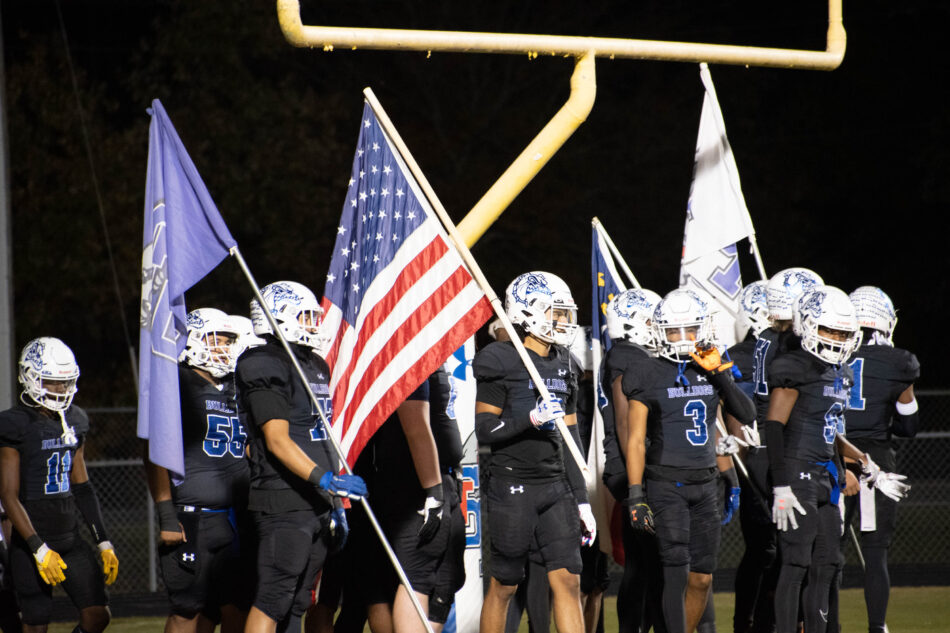One: Robeson County
The white Chevrolet van was headed south on Interstate 95 in North Carolina, halfway between Fayetteville and Lumberton late in the afternoon of the first Friday of November. If you didn’t know what state you were in, you might’ve mistaken the sun setting over the open fields and the vast green and yellow forests that lined the road for just about any freeway in North America.
Here, agriculture was the main industry. It had been that way for decades. Tobacco used to be the money crop, locals would say.
“Are you preparing to meet Jesus?” read one black and green billboard five minutes outside of St. Pauls, N.C., a town of 2,056. The van veered off the I95 and onto the Exit 33 offramp, then made a sharp left onto U.S. Route 301. There, you knew exactly where you were. Route 301 was a two-lane road, similarly lined by trees, now with large estates separating the thick forestry from the cars.
St. Pauls was a town straight out of the 1960s — except for the two properties with Trump–Vance signs displayed in the grass by the road. North Carolina was a battleground state that Donald J. Trump won by a slim margin in the 2020 Election — 49.9% to 48.5% — over President Biden.
A few miles down was St. Pauls High School. G.S. Kinlaw Stadium, the place where the town came together on Friday nights, was the first structure to come into view. It was a primitive venue with all the essentials: a scoreboard, press box and concession stands. Warm-up was underway for the St. Pauls Bulldogs’ game against the Midway Raiders, though with kickoff not scheduled for another hour, the crowd was scarce. The field was surrounded by a track. A set of metal bleachers stood behind each sideline, encased by a silver chain link fence and guarded by officers.
A large blue Trump banner hung off the porch of the white house on North Old Stage Road, across the street from the school’s main entrance. It greeted everyone who showed up for Friday night football, including the reporter and photographer who had jumped out of the van at the side of the school.
You may have heard of Friday Night Lights, the story of a high school football team’s quest for a state championship and life in a small town in rural Texas. High school football similarly plays a prominent role in the culture of rural North Carolina. It is what ice hockey is to the Canadians, what soccer is to the Brits and what baseball is to the Japanese.
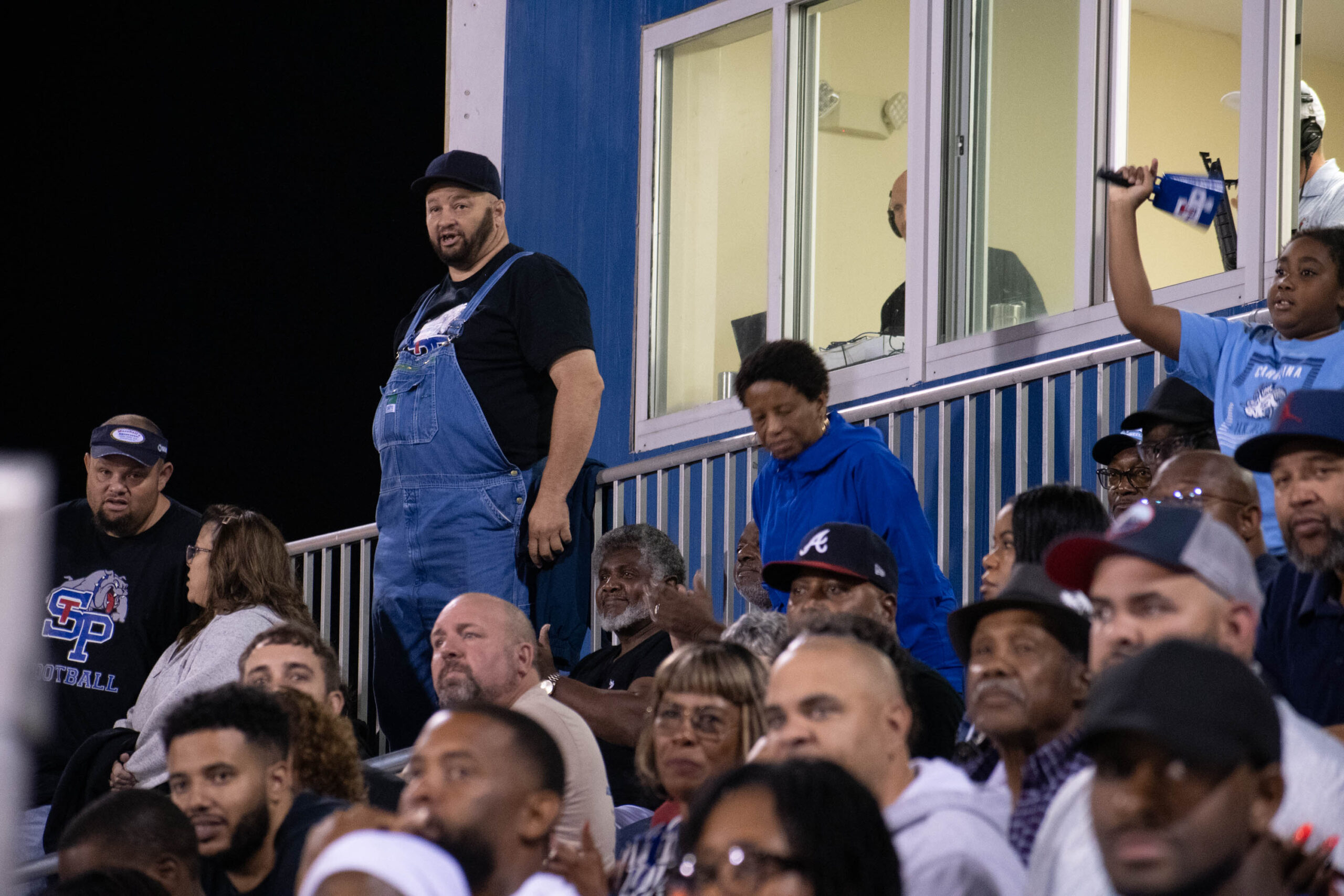
Fans look on during the St. Pauls Bulldogs vs Midway Raiders game, Nov. 1, 2024. (Photo by Sofie Kato.)
Two: St. Pauls
St. Paul’s High was guarded by two life size white bulldog statues. Many of its athletic facilities were painted in the Bulldogs’ blue and white — they were not only the school’s pride, but the local professional team.
The school sat across from the St. Pauls National Guard Armory, where the ASVAB tests, the assessment of a person’s potential and eligibility for military service, used to be administered. They were now taken at the school. About 35% of St. Pauls graduates end up going into the military, estimated Mike Setzer, the Bulldogs’ head coach. Entering service was one of the few stable career options in a county with 4.6% of its population currently without a job — 95th out of 100 in the state, according to the North Carolina Department of Commerce.
The best route out of Robeson County — pronounced Rob-esan, not Robe-esan, as the locals will correct you — was college, which the school encouraged its students to pursue, but only around 15% of its students did. There was an exclusive club beyond that, too. To be part of the 1% of high school athletes who went on to play a sport at a Division 1 school, football was your ticket to ride.
Admission was $8, cheaper than college football and a bargain compared to the $49 required to get into the Carolina Panthers game in Charlotte on Sunday. This was bound to be better football anyway, no disrespect to the 1–7 Panthers. St. Pauls and Midway were tied for first place in the 2A Southeastern Conference. “A de facto conference championship” was how Chris Stiles, the Robesonian’s sports editor, described that night’s contest.
The last home game of the regular season was also seniors’ night, where St. Pauls would honor its graduating players. This year, that group included Coach Setzer’s son, the Bulldogs’ quarterback, Theophilus. At 6:30 p.m., half an hour before kickoff, the graduating players and their families were announced to the crowd. They walked the track in front of the home bleachers and were met by much fanfare, the same way a professional team’s fan base would salute a legend after his last game.
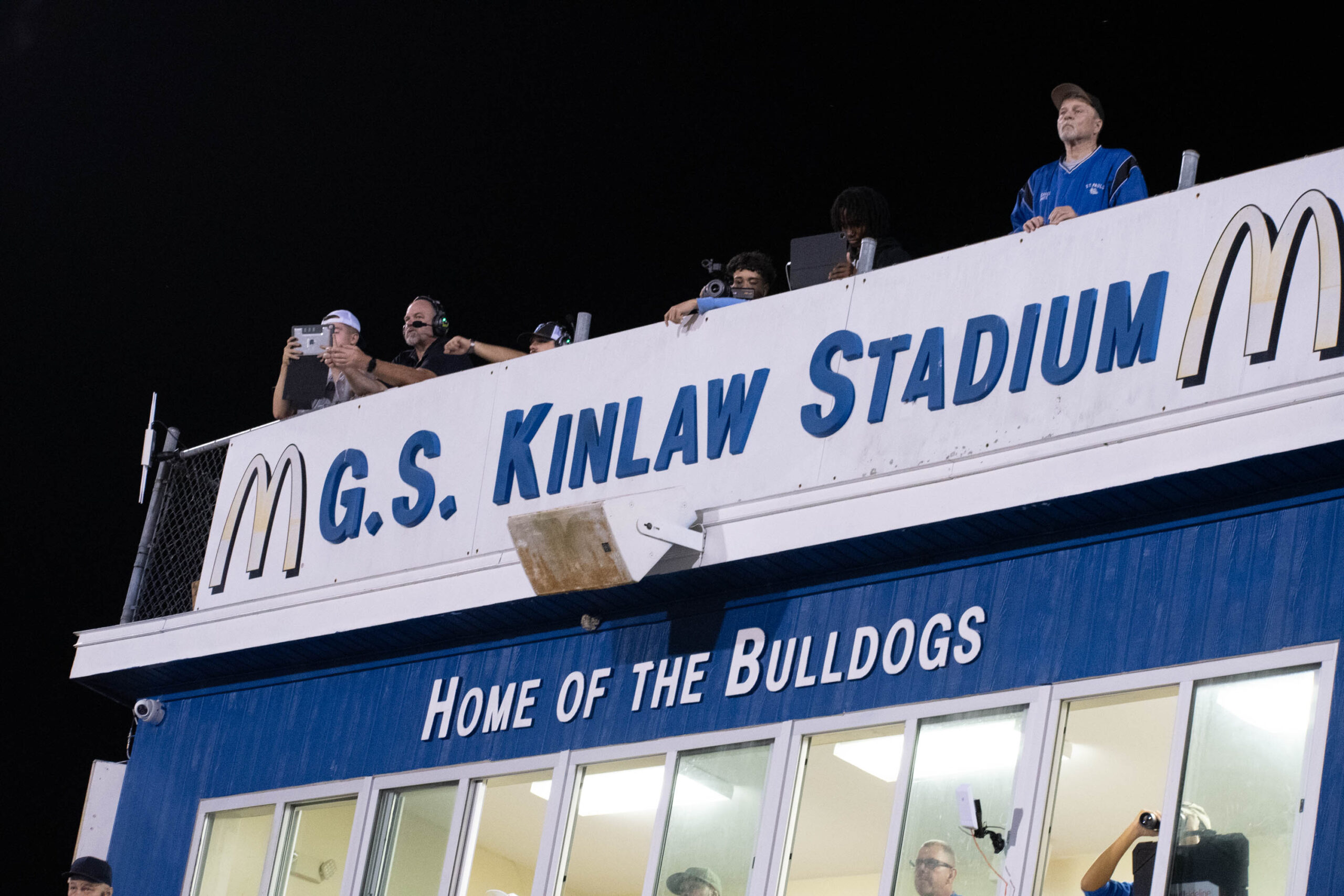
G.S. Kinlaw Stadium during the St. Pauls Bulldogs vs Midway Raiders game, Nov. 1, 2024. (Photo by Sofie Kato.)
Three: The Sports Reporter
Stiles, 29, arrived at 6:42 p.m., 12 minutes later than we had planned to meet. He had been held up by the security line, he said.
The queue of fans awaiting the black metal detector by the gate, which was guarded by two men and three police cars, had by now reached the parking lot. Robeson County had the highest crime rate in North Carolina in 2022, with 5,788 crimes per 100,000 residents, according to the North Carolina State Bureau of Investigation. That year, the Robeson County Sheriff logged the highest number of offenses, with 3,358.
“There’s pockets where that happens,” said Stiles. “And then there’s pockets where I’ve never seen an issue, but a lot of these kids do either come from backgrounds connected to that, or at the very least, it’s in the back of everyone’s mind.”
Stiles didn’t mind the heightened safety measures. Metal detectors had been the standard at football and basketball games in Robeson County for years. Security was tightened in September 2023 after a parking lot shooting at a football game in Lumberton.
The parking lot behind St. Pauls was illuminated by large white spotlights, almost as bright as the field. Inside the stadium, officers patrolled the grass surrounding the bleachers. Mosquitos filled the air as the sun went down.
Stiles, a native of South Carolina, had been at the Robesonian for a little over five years. He wore a black polo with green stripes, his media pass dangling around his neck. He spoke in a thick southern accent.
We spoke over the pregame announcements that blared through the speakers next to the home bleachers, behind the players’ families who had posted up next to the fence behind the track. Many of them brought foldable lawn chairs to watch the game.
“A very community-driven event,” Stiles described football at St. Pauls.
On the other side of the bleachers were the concessions, all operated by locals. There was Harold Whitted, 63, a retired textile factory worker who sold pork skins at the games for $7. And there were the “cheer mamas,” as they called themselves: the moms of the St. Pauls cheer team who at every game sold ice cream to raise money for the squad to go to nationals.
Such an atmosphere was paramount, not only in a poverty and crime stricken county, but with four days until the election. Out here, Stiles said he hadn’t seen many political messages.
“It may be too strong to say an escape, because it’s still on everybody’s mind,” Stiles said. “It’s what, four days from the election? But everybody’s here to cheer on their team.”
Stiles spent the whole game on the field. He was a one-man reporting machine. He followed the play up and down the sidelines. He took notes of each scoring drive, after which he immediately swapped his notebook for his camera to capture the celebration. At halftime, he conducted interviews by the home benches.
He was busy on game nights, and said that people in the stands could be having political conversations that he wasn’t aware about. He hadn’t heard much, though.
“Tonight is mostly about the seniors,” he added.

The St. Pauls Bulldogs and Midway Raiders line up, Nov. 1, 2024. (Photo by Sofie Kato.)
Four: The Superintendent
Stiles pointed at a man in a navy tracksuit standing alone at the end of the field.
“The man in the blue hat over there,” he said. “Is actually the superintendent of Robeson County Schools.”
A muffled recording of “The Star-Spangled Banner” played over the speakers, briefly halting the pregame chatter among the fans.
The superintendent’s name was Freddie Williamson, 68. He used to be the principal of Midway High School, the visiting team. He became the superintendent of Public Schools of Robeson County in 2020. He’d been a superintendent for nearly two decades, spending his first 15 years in the role for Hoke County, which was about 35 minutes northwest of St. Pauls.
“One team, one goal” was Williamson’s motto, according to the PSRC website. He was the man who had helped Robeson County schools rebound from COVID–19 faster than the state average. He was the voice for the future of a county where 21% of its residents in 2022 did not have a high school diploma.
Williamson had developed school leadership teams while helping the district recover from COVID–19. His work earned him the title of 2024–25 regional superintendent of the year for the Sandhills Region. In his new role, he mentors new superintendents, he said.
The superintendents faced many challenges, he said, but one of the main issues affecting local schools was resources. This summer, PSRC had asked for an additional $19.5 million in local funding to increase the salaries and benefits of teachers. Though Williamson said that politics were prevalent in all walks of life, his priorities lay with the students.
“The question is,” said Williamson, “How do we use politics to further public education? That’s your challenge. Can we lay our differences down for a cause? And that’s the state of North Carolina and educating our kids.”
In front of us, the Bulldogs took the field for the final time in the 2024–25 regular season. The crowd, which had steadily filled over the past 45 minutes, cheered. The train horn blasted. It was game time.
Seventy to 75% of local high school graduates remain in Robeson County, according to Williamson. In a private school in Raleigh, the institution’s role might be to help its students get into a top-rate college or university. Here, Williamson’s message was simple: teach the kids right from wrong and how to be good people.
“One of the things that education ought to do is help young adults understand their responsibility towards citizenship and the future,” he said. “Education does that.”
Football was the escape, the activity that brought the school together and the town to its feet on Friday nights. For some, it was the glimmer of a future outside of the county.
“For certain kids, it gives them that hope of that scholarship opportunity for a college education,” Williamson said. “It’s creating life, stories, memories for kids that play, just being part of an organized team. So it’s important in small, rural towns.”
Amid all the challenges facing the schools of Robeson County, Williamson was optimistic about the region’s future. Brighter days were ahead.
“It’s a wonderful place to live,” Williamson said. “A wonderful place to work, and it’s a growing county with I95 expansion. We’re excited about the future.”
He walked onto the field, joining the group of school and district employees by the green John Deere UTV parked near the endzone.
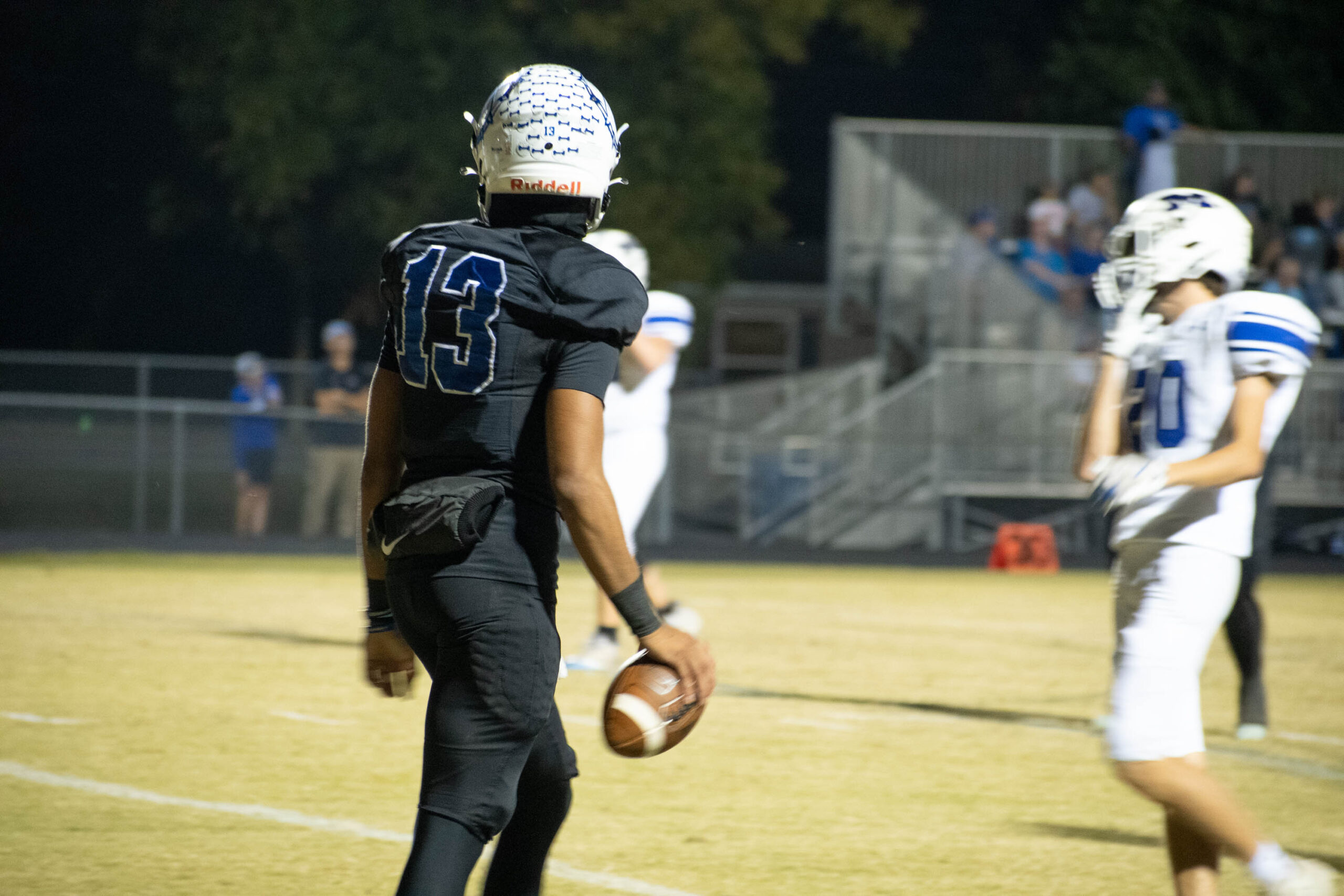
St. Pauls Bulldogs’ quarterback Theophilus Setzer (13) celebrates a rushing touchdown against the Midway Raiders, Nov. 1, 2024. (Photo by Sofie Kato.)
Five: Number 13
Friday night football was now underway, and William Sampson, 25, stood a few feet behind the field at the 10 yard line. He was a first cousin of Theophilus Setzer, the senior, the coach’s son and the future D1 quarterback. Sampson was also a nephew of Coach Setzer.
With the Setzer boys starring on the field, Sampson grew up in a football family. Theophilus, 18, was the third of Coach Setzer’s sons with a D1 football path awaiting him in his final year of high school — his two older brothers both played for the Duke Blue Devils.
Sampson went to Fairmont High School, which was also in Robeson County, 35 minutes south on the I95. He, too, grew up playing sports, backed by the support of his family. He now worked for UPS, he said in a southern accent. He wore jeans, a black t-shirt and brown boots.
“Robeson County has wonderful athletes,” said Sampson. “But you got to escape from this county in order to do something with it.”
As Theophilus, Coach Setzer and their immediate family had walked the track before the game, Sampson followed along the sideline, snapping pictures on his phone. He documented the memories of a county and a childhood that would last a lifetime, but before the game that would act as a springboard for so much more.
The Setzers had now returned to their normal positions: Theophilus on the field as the Bulldogs’ signal caller; his father on the sideline, leading the team he’d coached on-and-off for the past 22 years.
“I’m super proud of my cousin,” Sampson said. “I want him to look up to me. We’re proud of him as a family.”
Half the players on the gridiron wore the same nameless black uniform with blue numbers outlined in white. There was one you watched — number 13. He sifted through the Raiders’ defense. He could rush. He could throw. Theophilus Setzer could do it all. Tonight, under the lights at a high school in rural North Carolina. In a few months, maybe on national television, capturing the hearts of a fanbase much bigger than St. Pauls, but similarly devoted.
With great talent came great pressure, and adversity that set himself apart from his peers. Playing in North Carolina’s poorest county placed limitations on many of his teammates — the disparity in income, education and resources at the forefront. For Theophilus Setzer, his kryptonite was playing in the shadow of his two older brothers, Kane Banner and Sayvon Sampson.
“Having such a high standard being set by my family,” said Theophilus. “That’s really the main obstacle that pushes me throughout the whole time I’ve been here.”
Theophilus was one of two graduating players this year who was on track to play college football, his father said. St. Pauls normally had six or seven, ranging from D1 to D2 schools. He didn’t know what school he was going to. He mentioned that he had a few D1 offers.
If Theophilus had any self-doubt, he didn’t show it. With 25 seconds left in the first quarter and his team in the red zone, he dashed toward the corner of the endzone. He evaded the Midway defenders and danced in a rushing touchdown to put his team up 15–8. It was one of the five touchdowns he was a part of that night — three rushing, two in the air. Theophilus completed seven of 13 pass attempts and threw for 134 yards.
In position was Stiles. He marked the scoring play on his large notepad. Then, in a swift handoff, he captured the celebrating Bulldogs with his camera. Click. Click. Click. Behind Stiles, on the track, the St. Pauls cheer team waved to the crowd.
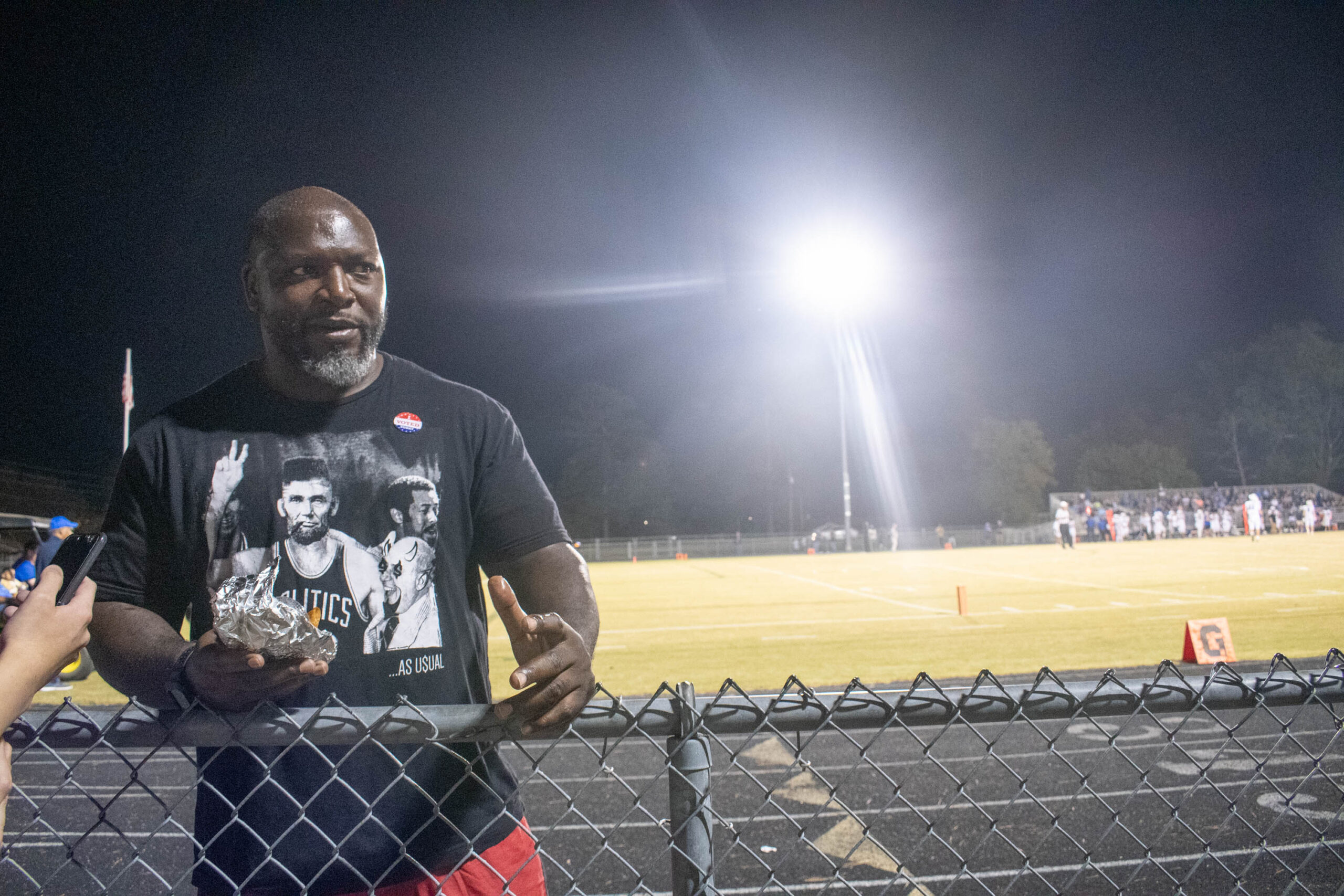
Former NFL fullback and Super Bowl champion Vonta Leach stands by the sideline at halftime during the St. Pauls Bulldogs vs Midway Raiders game, Nov. 1, 2024. (Photo by Sofie Kato.)
Six: Vonta Leach
At halftime, Vonta Leach, the former NFL fullback, stood by the cart at the end of the field. He was wearing a black t-shirt and red pants.
As Leach walked toward the fence, his shirt revealed Abraham Lincoln in a Boston Celtics jersey, with text that combined to say, “Politics as usual.” Affixed to his left chest was a white, red and blue “I voted” sticker.
“Politics is you,” said Leach, 43. “I went to vote. Tell everybody, get out and vote.”
Leach helped the Baltimore Ravens win Super Bowl XLVII as Ray Rice’s lead blocker. He was a local legend, one of the few success stories to come out of Robeson County. He was born and raised in Rowland, and attended the now-shuttered South Robeson High School He graduated in 2000.
He played college football for the East Carolina Pirates. After going undrafted, he was signed by the Green Bay Packers.
His 2006 season got off to a rocky start. The Packers released him. The New Orleans Saints picked him up, then released him. Hit after hit. Most undrafted players would’ve given up. Leach didn’t. The Houston Texans eventually signed him.
“Perseverance, hard work,” he said. “Just stuck with it, stayed the course.”
“I failed a couple of times. Not how many times you fail, it’s how many times you want to get back up and fight and work.”
Leach was now the chairman of the Robeson County Board of Education, his home county that he returned to after his NFL career. He’s also an ambassador for the Ravens and the Texans, the two pro franchises he spent the bulk of his playing career with. He wanted to make a difference in Robeson County. His daughter was enrolled in the system. He grew up in it. He had a front row seat to the lack of resources available to its residents and schools.
Leach’s work started with the youth. He led football and cheer camps. He supported a Christmas gift card program. In 2020, he got involved in local politics when he was elected to the Board of Education.
“I could have taken my kids anywhere and paid for their education,’’ Leach told the Fayetteville Observer in March 2020, prior to being formally sworn into his position. “But so many people in Robeson County don’t have the resources and means to do that. I wanted to be a voice for my kids and all those across Robeson County. I thought, ‘What better way to help make a change for the kids in Robeson County than joining the school board?’”
In this role, Leach oversaw the policies and procedures of the schools, he said. Football remained an integral part of him. On Friday nights, you’d find him at one of the local high school games.
“Whatever the biggest game in the county is,” he said. “I’m a sports fan.”
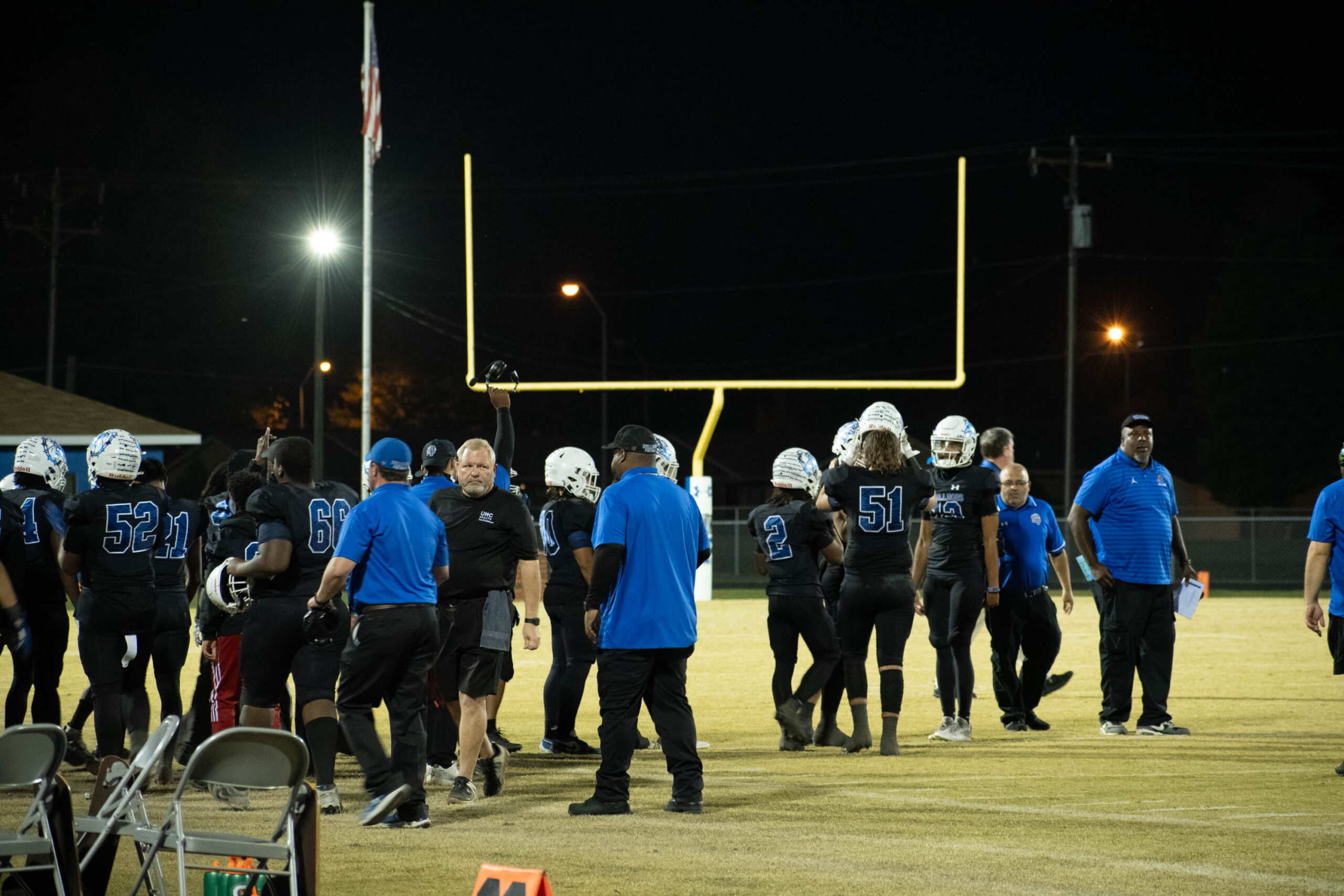
The St. Pauls Bulldogs gather on the field following their 59–22 win over the Midway Raiders, Nov. 1, 2024. (Photo by Sofie Kato.)
Seven: Coach Setzer
Every great athlete has a mentor or two. Leach had his mom and his grandma, he said. But the consistent face of the Bulldogs for the better part of the last two decades was their head coach, Mike Setzer, 49. He was the role model for every one of his players, leading them not only on the field, but helping them build a foundation for a better life off it.
“Nothing but a father figure,” one of his players told the Robesonian in 2022 when Coach Setzer became the most successful coach in St. Pauls history with his 65th win. Fitting, yes. He had coached his three sons at St. Pauls, after all. He was also a man who cared deeply about every one of his players.
You can see it in the way the Bulldogs, kneeled in their endzone following a convincing 59–22 win over Midway, looked up at their coach during his post-game address. All eyes focused on the man before them.
Coach Setzer was not from Robeson County. He was a transplant, he called himself. He hailed from the western part of the state. Yet, he’d been the face of Bulldogs football since 2002, when he first stepped into St. Pauls’ head coaching job. He was now in his second stint in the role.
As his kids grew up in the area, so did Robeson County. The school system used to be centered around agriculture, Setzer said. When the tobacco crop came in, they’d take school off. This wasn’t the case anymore, he added, but the county’s past still caused school to take a back seat at times.
Add in the struggle of living in North Carolina’s poorest county, steeped in crime and located far from the recruiting hotbeds of Raleigh and Charlotte, the future on paper was dim for Robeson athletes.
“I like to fish,” said Setzer. “I’m blessed to have a pond at my house, and there’s certain areas in my pond that I can tell you that you’re guaranteed to catch a fish.”
The same was true for recruiting, he explained. Teams canvassed the big cities first. Only then did they venture out to the smaller areas like Robeson County, which, despite being located in the I95 corridor, was over an hour from Raleigh, and two-and-a-half hours from Charlotte.
Football was a challenging pathway out of Robeson County, yet it was the best avenue for change. The sport carried many lessons. It kickstarted the conversation for kids to start thinking about their futures. Futures beyond Robeson County, and beyond sports, too.
“It’s a catalyst to get our kids to thinking about the opportunity to do something on another level and to go to higher learning,” said Setzer. “We are the poorest county, so we try to keep it honest with our kids. We use football as a way for them to get, if you would, a sample of the outside world.”
Football didn’t last forever. Every playing career would come to an end. It might be a game like that night, seniors’ night in high school. Others, like the two older Setzer brothers, would play at college. A select few, like Vonta Leach, would make it to the big leagues. But they all had to move on.
There was some solace in the journey. We stood witness to it that Friday night. For three hours, time froze. The town gathered together to watch its local team play. The families of the graduating players came out for what could’ve been the final time of their high school careers.
The football dream began in Robeson County. For some, the game would take them beyond the state line. For many, the journey would end here. As the constant cycle of players came and went, the mainstay was the town gathering on Friday evenings, at high school football games rooted deep in the culture of the south.
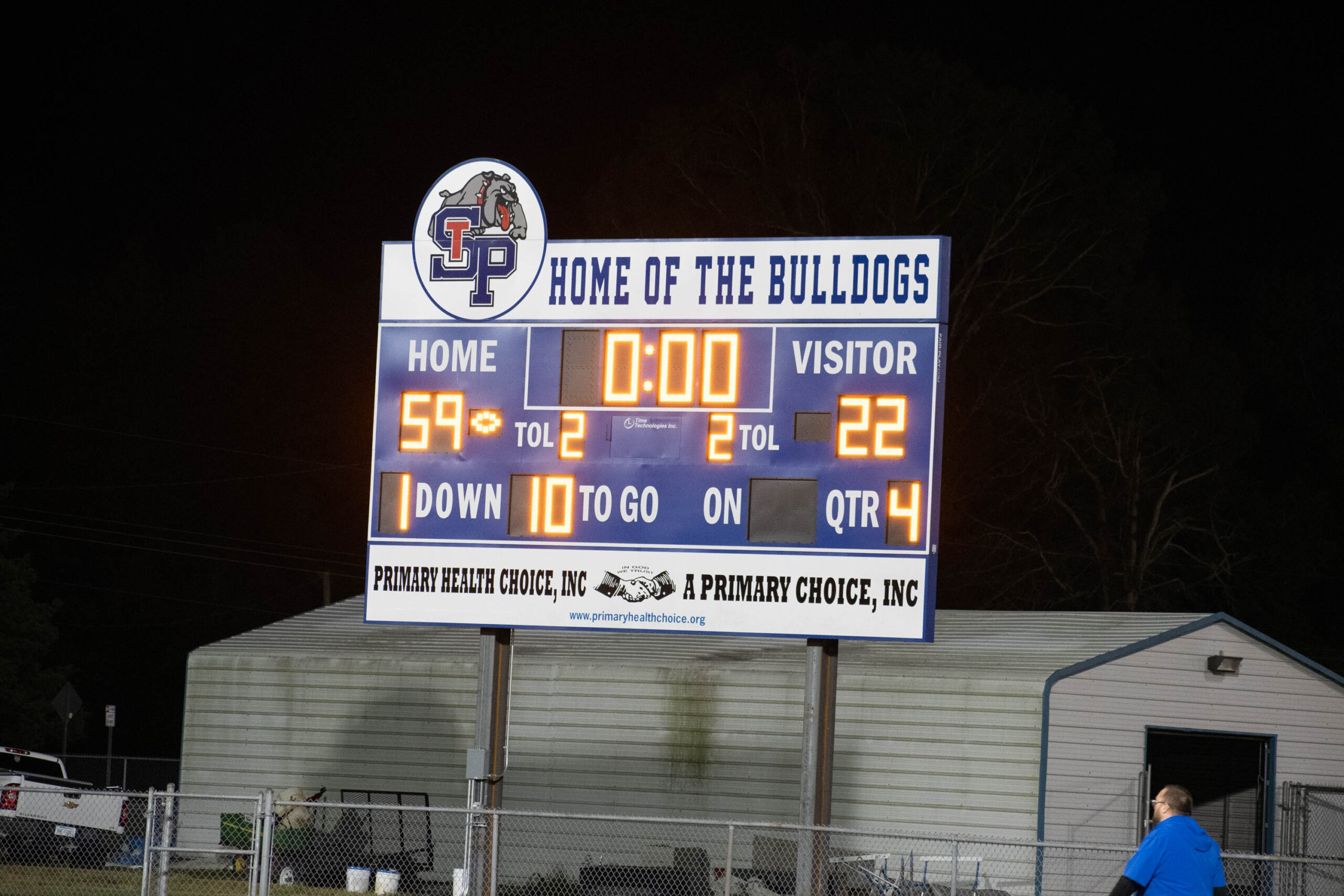
The G.S. Kinlaw Stadium scoreboard after the St. Pauls Bulldogs vs Midway Raiders game, Nov. 1, 2024. (Photo by Sofie Kato.)
